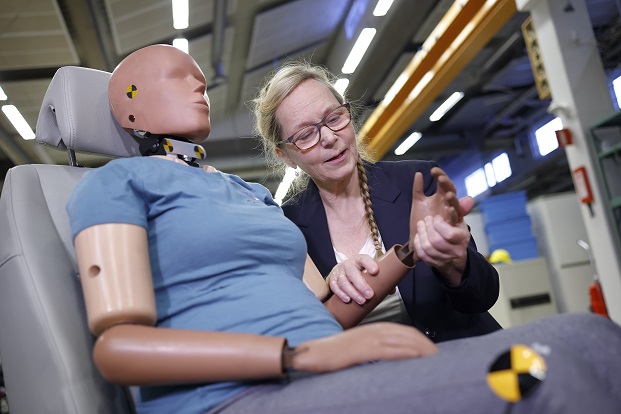Swedish road safety researcher, Astrid Linder receives a Woman of Worth award for her work on female crash test dummies
Linder works at VTI, the Swedish National Road and Transport Research Institute, and is also an assistant professor at Chalmers University, Sweden. Her work focuses on research in crash safety and biomechanics, with a particular focus on the development of dummies to assess risk in the event of an accident. One of Astrid’s goals is to have crash protection studied for both men and women. Together with her colleagues at VTI and Mats Svensson of Chalmers University, they have developed the first medium-sized female crash test dummy.
In the 1990s, Linder’s PhD project involved developing the world’s first crash test dummy for low-speed collisions to assess the protection for soft tissue injuries of the neck, so-called whiplash injuries. At the time, there was no dummy or test for the type of collision that is the most common resulting in disabling injuries. The resulting dummy was the size of an average man, as that is the model of the occupant that is used as the driver in both frontal and side impact testing.
However, a review of available literature at the time showed that women were at higher risk of sustaining whiplash injuries than men. It therefore became a logical next step to design a model that represents women.
According to Linder, how the body is constructed does not differ between men and women when you look at the big features such as skeletal parts, organs and soft parts except the reproductive organs which are not essential in crash safety. Differences that are important to include in models for evaluating protection against injuries in a low-speed rear-end collision are things like upper body geometry, such as shoulder width and center of gravity of the torso, which are higher for men than women. Crash safety evaluation is typically done using an average (geometry, weight and height) man as the driver.
“In addition we test with child models. To represent children, we have child dummies in many different sizes. Volvo has done tests with a pregnant model but protection for women was not studied, as the model was not designed as an average woman. What drives me are the injury statistics that provide the basis for what needs to be developed and to make it possible to better identify the innovations that give the entire population the best protection. The work has been going on for more than 20 years,” says Linder.
Now, Linder is working on changing the future of crash tests using crash dummies and tools that inclusively represent both the female and male so that the cars that give the entire population the best protection in the event of a crash can be identified in testing. However, the road will not be quick or straightforward.
“In the regulations for type approval tests used in Europe, it is clearly stated that what is required for roadworthiness tests is that a model of an average man must be used. And as long as it says so in the regulations, the change will not come from society’s demands. The companies follow what needs to be followed, nothing more can be required. To get ahead, cooperation, knowledge and will are needed, among other things,” she concludes.
- UK manufacturing steps up to COVID-19 crisis - April 2, 2020
- Clustering Innovation - March 12, 2020
- A Global Monitor - March 6, 2020

